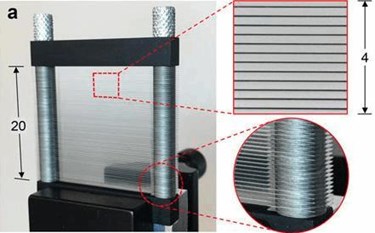Researchers Create Beamsplitter For Polarizing Light At Terahertz Frequencies
By Jof Enriquez,
Follow me on Twitter @jofenriq

Researchers at Brown University and Osaka University have developed a technique to polarize light for terahertz waves using a new type of beamsplitter made from stacks of spaced metal plates. This affordable and versatile method could be readily applied to create new components in a wide range of systems that utilize terahertz radiation, from imaging systems to future communications networks.
Terahertz radiation, which lies between microwave and infrared in the electromagnetic spectrum, has myriad potential applications, but few off-the-shelf components are currently available.
Brown researchers have been trying to fill the gap through development of devices harnessing terahertz wavelengths. Last year, they unveiled a new type of lens for focusing terahertz radiation. Utilizing the same technique of using spaced metal plates, they proceeded to make another terahertz device — a polarizing beamsplitter to separate light waves according to their polarization state.
Typically, polarization is manipulated in the terahertz range using polarizing filters with an array of micron-sized metal wires spaced several microns apart. In the method developed by Brown and Osaka researchers, instead of having more expensive and fragile wires, a polarizing beamsplitter is constructed using a stack of closely-spaced steel plates acting as waveguides — a medium also called an "artificial dielectric."
"The artificial-dielectric concept also makes the device more versatile," said Rajind Mendis, a research assistant professor at Brown, and research team leader. "The device can be easily tuned for use at different terahertz frequencies simply by changing the size of the spacers separating the plates or by changing the illuminating angle."
"When terahertz light is shined on the stack at a 45-degree angle, it splits the beam by exciting two waveguide modes. One beam of vertically polarized light passes straight through the device, while another beam of horizontally polarized light is reflected in a 90-degree angle from the original beam axis," stated the press release.
Building on the same idea, the researchers added a second similar artificial dielectric structure to produce another device called a terahertz isolator, which is used on high-powered lasers to prevent reflected light from damaging a laser emitter.
The Brown and Osaka research teams believe manipulating polarization using terahertz devices made of cheaper materials — built using their versatile, reproducible method — is the way to go in building advanced terahertz systems.
"Because these waveguide-based artificial dielectrics are low loss, inexpensive, and easy to fabricate, this approach offers a promising new route for polarization control of free-space terahertz beams," they wrote in the July 19, 2017 online edition of Scientific Reports.
